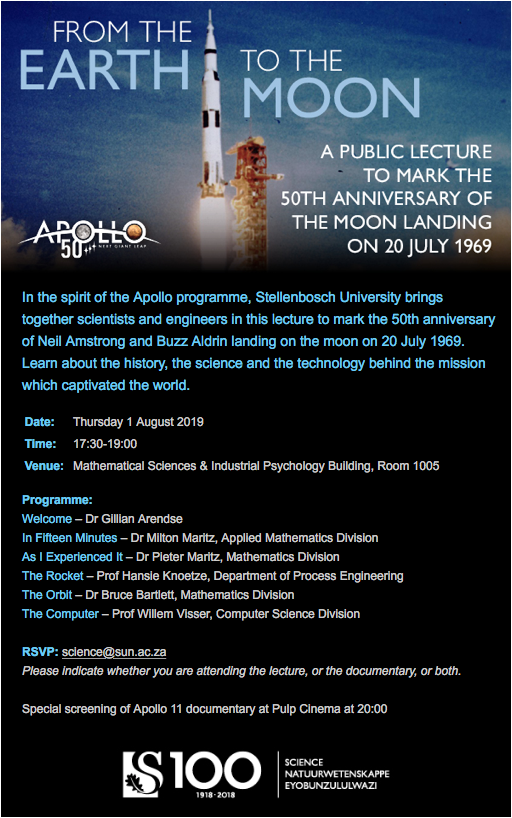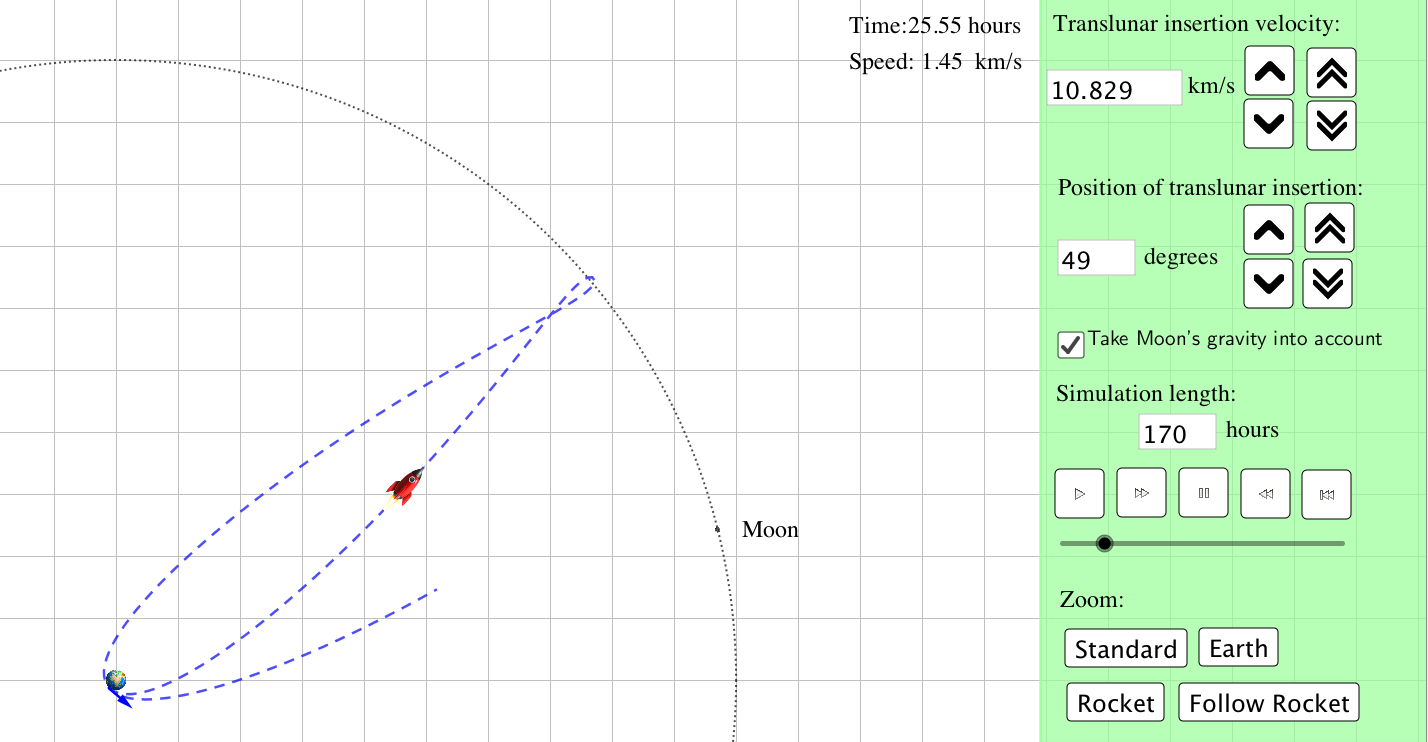
At 9:32am on the 16th of July 1969, the Apollo 11 astronauts Neil Armstrong, Buzz Aldrin and Michael Collins launched off in their Saturn V rocket from Cape Canaveral. Three days later, Armstrong and Aldrin landed on the moon, a historic moment.
The following interactive simulations of their flight, made with the free software GeoGebra, commemorate the 50th anniversary of the Apollo 11 mission. All distances, including the radius of the earth and the moon (but not the size rocket!) are drawn accurately to scale.
To jump to a the main Moonshot! simulation of the figure-eight free return orbit that Apollo 11 used, click here (there is also a stand-alone version). Otherwise, read on!
Update: There will also be a "From The Earth To The Moon" public lecture on 1st August!

The rocket launched at 9:32am, initially going straight up vertically, but then gradually heading east (to be precise, 72 degrees east of north) over the Atlantic as its altitude incresed. After 8 minutes and 11 seconds, its engine stopped firing. It had reached a "parking orbit" around the Earth. Its altitude was 190km, and its speed (with respect to the fixed background stars) was 7.7km/s. At this speed, it takes about 90 minutes to go around the earth.
The following applet simulates this parking orbit. Once the applet is loaded (which can take some time), press "play" to start the simulation. Press the "full screen" button in the lower right corner to make your life easier.
Make the initial velocity a bit bigger, and notice how the orbit becomes elliptical. When the orbit becomes very large, you will need to zoom out to "Moon scale". Notice how, as you approach about 11km/s, the orbit rapidly becomes infinitely large. You have reached escape velocity!

After orbiting one and a half times around the Earth, and 2 hours and 52 minutes into the mission, the most incredible moment in human exploration occured. They ignited the third stage of the Saturn V rocket one final time, and injected themselves into an orbit around the moon! This was called Translunar Injection (TLI). This was only the second time in history that human beings escaped the gravity of their home planet. The first? Apollo 8, whose crew (Frank Borman, James Lovell and Bill Anders) had six months earlier gone on the same flight trajectory to the moon, orbited around it, and came home, as a warm-up for Apollo 11.
Leaving Earth's orbit is scary. What if the engines failed, and they couldn't get home? To make the mission as safe as possible, the rocket was placed into a free-return orbit. On such an orbit, the rocket coasts around the leading edge of the moon in a "figure-eight" shape and returns to earth, only using gravity. As long as life-support has not failed, you are guaranteed to be able to come home! This is exactly what happened with Apollo 13 (although, they had to make some small corrections).
The existence of these incredible free-return "figure-eight" orbits had long been believed to exist by earlier scientists such as Poincare (1854-1912). However it was only in 1962 that a mathematician working for NASA, Richard Arenstorf, rigorously proved that they indeed exist. Indeed, he showed that there is a whole family of them. For this, he was awarded the NASA Exceptional Scientific Achievement Medal in 1966. If you strap yourself to a rocket and aim for the moon, it's comforting to know that someone has proved that you can make it back!
The "free-return" orbit was achieved by firing ("burning") the third stage of the Saturn V rocket for 5 minutes and 47 seconds. It took their velocity from 7.7km/s up to 10.8 km/s. If you played around with the "parking orbit" above, you'll already know that this is just under escape velocity! But the rocket doesn't escape. It crosses just past the leading edge of the moon, and slings around it, ultimately returning to earth in a figure-eight movement.
The parameters for this burn were read up to the crew by Mission Control. (The audio and transcript can be found at the fantastic Apollo Flight Journal website by David Woods). The rocket ignited at 2:45:22 into the mission. Five minutes later, it was all over. Neil Armstrong told Mission Control, "That Saturn gave us a magnificent ride." The astronauts were on their way to the moon.
The following applet simulates this figure-eight translunar insertion orbit. It is not exactly the same as the trajectory that Apollo 11 actually took, but it is very close. Start by loading the simulation - this can take quite a while. Then, once it is loaded, to start the simulation, press the "fast play" button, which looks like this:

Watch how the rocket swings around the moon and comes back to Earth. As before, you may want to make your life easier by going "full screen", by pushing the square button at the bottom right corner.
The goal of TLI is to time your "rocket burn" so that you slingshot around the earth, and reach the moon, but just ahead of it. Then its gravity swings you round again, and you are on your way home, and come back to where you started. Push the "Follow Rocket" button to see how close you come to hitting the moon. Change the velocity and burn position to see how sensitive the whole setup is. A journey for the ages!

